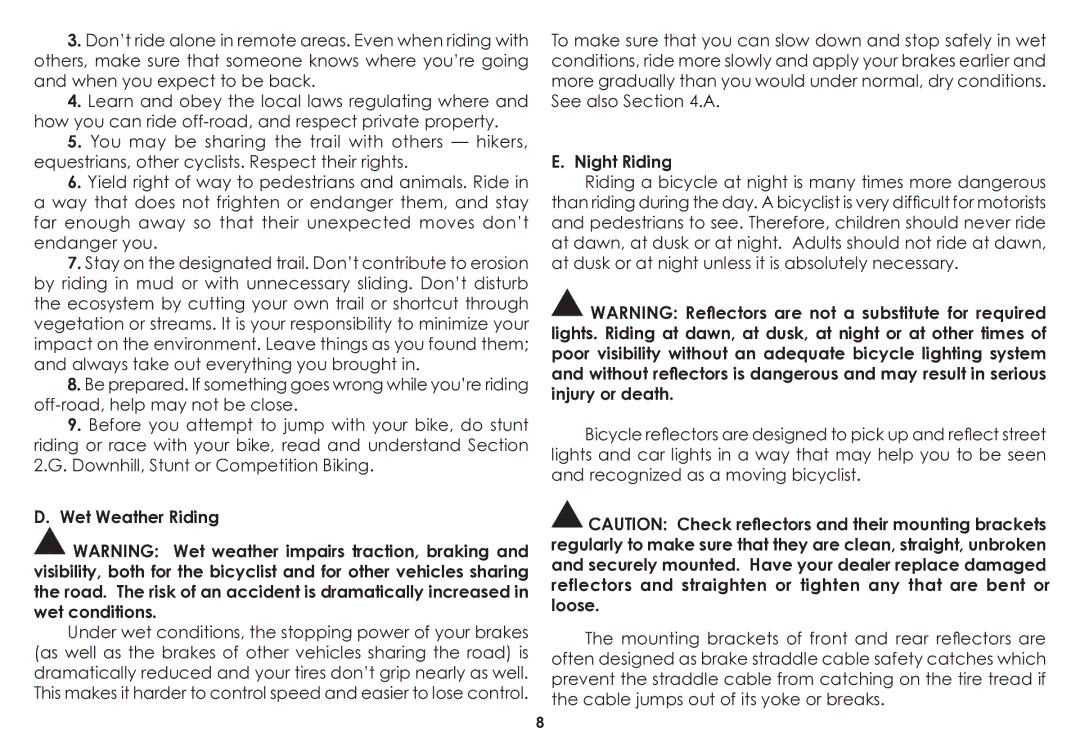
3.Don’t ride alone in remote areas. Even when riding with others, make sure that someone knows where you’re going and when you expect to be back.
4.Learn and obey the local laws regulating where and how you can ride
5.You may be sharing the trail with others — hikers, equestrians, other cyclists. Respect their rights.
6.Yield right of way to pedestrians and animals. Ride in a way that does not frighten or endanger them, and stay far enough away so that their unexpected moves don’t endanger you.
7.Stay on the designated trail. Don’t contribute to erosion by riding in mud or with unnecessary sliding. Don’t disturb the ecosystem by cutting your own trail or shortcut through vegetation or streams. It is your responsibility to minimize your impact on the environment. Leave things as you found them; and always take out everything you brought in.
8.Be prepared. If something goes wrong while you’re riding
9.Before you attempt to jump with your bike, do stunt riding or race with your bike, read and understand Section 2.G. Downhill, Stunt or Competition Biking.
D.Wet Weather Riding
![]() ! WARNING: Wet weather impairs traction, braking and visibility, both for the bicyclist and for other vehicles sharing the road. The risk of an accident is dramatically increased in wet conditions.
! WARNING: Wet weather impairs traction, braking and visibility, both for the bicyclist and for other vehicles sharing the road. The risk of an accident is dramatically increased in wet conditions.
Under wet conditions, the stopping power of your brakes (as well as the brakes of other vehicles sharing the road) is dramatically reduced and your tires don’t grip nearly as well. This makes it harder to control speed and easier to lose control.
To make sure that you can slow down and stop safely in wet conditions, ride more slowly and apply your brakes earlier and more gradually than you would under normal, dry conditions. See also Section 4.A.
E. Night Riding
Riding a bicycle at night is many times more dangerous than riding during the day. A bicyclist is very diffi cult for motorists and pedestrians to see. Therefore, children should never ride at dawn, at dusk or at night. Adults should not ride at dawn, at dusk or at night unless it is absolutely necessary.
!![]() WARNING: Refl ectors are not a substitute for required lights. Riding at dawn, at dusk, at night or at other times of poor visibility without an adequate bicycle lighting system and without refl ectors is dangerous and may result in serious injury or death.
WARNING: Refl ectors are not a substitute for required lights. Riding at dawn, at dusk, at night or at other times of poor visibility without an adequate bicycle lighting system and without refl ectors is dangerous and may result in serious injury or death.
Bicycle refl ectors are designed to pick up and refl ect street lights and car lights in a way that may help you to be seen and recognized as a moving bicyclist.
!![]() CAUTION: Check refl ectors and their mounting brackets regularly to make sure that they are clean, straight, unbroken and securely mounted. Have your dealer replace damaged reflectors and straighten or tighten any that are bent or loose.
CAUTION: Check refl ectors and their mounting brackets regularly to make sure that they are clean, straight, unbroken and securely mounted. Have your dealer replace damaged reflectors and straighten or tighten any that are bent or loose.
The mounting brackets of front and rear refl ectors are often designed as brake straddle cable safety catches which prevent the straddle cable from catching on the tire tread if the cable jumps out of its yoke or breaks.
8
